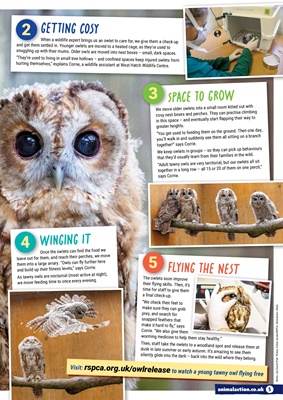
GeTtInG cOsYWhen a wildlife expert brings us an owlet to care for, we give them a check-up
and get them settled in. Younger owlets are moved to a heated cage, as they're used to
snuggling up with their mums. Older owls are moved into nest boxes - small, dark spaces.
"They're used to living in small tree hollows - and confined spaces keep injured owlets from
hurting themselves," explains Corrie, a wildlife assistant at West Hatch Wildlife Centre.
SpAcE tO gRoW
We move older owlets into a small room kitted out with
cosy nest boxes and perches. They can practise climbing
in this space - and eventually start flapping their way to
greater heights.
"You get used to feeding them on the ground. Then one day,
you'll walk in and suddenly see them all sitting on a branch
together!" says Corrie.
We keep owlets in groups - so they can pick up behaviours
that they'd usually learn from their families in the wild.
"Adult tawny owls are very territorial, but our owlets all sit
together in a long row - all 15 or 20 of them on one perch,"
says Corrie.
WiNgInG iT Once the owlets can find the food we
leave out for them, and reach their perches, we move
them into a large aviary. "Owls can fly further here
and build up their fitness levels," says Corrie.
As tawny owls are nocturnal (most active at night),
we move feeding time to once every evening. FlYiNg tHe nEsT
The owlets soon improve
their flying skills. Then, it's
time for staff to give them
a final check-up.
"We check their feet to
make sure they can grab
prey, and search for
snapped feathers that
make it hard to fly," says
Corrie. "We also give them
worming medicine to help them stay healthy."
Then, staff take the owlets to a woodland spot and release them at
dusk in late summer or early autumn. It's amazing to see them
silently glide into the dark - back into the wild where they belong.
4
5
3
2
Visit: rspca.org.uk/owlrelease to watch a young tawny owl flying free
Words: Lily Church-Pratt. Photos: Emma Jacobs/RSPCA. Illustrations: iStock
5
animalaction.co.uk